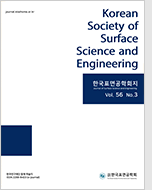
- Past Issues
- e-Submission
-

2021 Impact Factor 1.766
5-Year Impact Factor 1.674
Editorial Office
- +82-2-563-0935
- +82-2-558-2230
- submission@kssse.or.kr
- https://www.kssse.or.kr/

2021 Impact Factor 1.766
5-Year Impact Factor 1.674
The Korean Society of Surface Science and Engineering 2024;57(4):285-295. Published online: Sep, 9, 2024
DOI : 10.5695/JSSE.2024.57.4.285
PVDC-resin transforms into porous carbon through the removal of heteroatoms during heat treatment. When PVDC-resin mixed with chemical agent undergoes heat treatment, it transforms into porous carbon with a significant surface area. In this study, we aim to produce porous carbon using PVDC-resin as a precursor by mixing it with an inexpensive CuO agent in various ratios (1:1, 1:2) and varying the process temperatures (750°C, 950°C). To utilize the developed porous carbon as electrode for supercapacitors, this study explored the formation of micropores and mesopores during the activation process. The porous characteristics and specific surface area of the synthesized porous carbon were estimated using N2 isotherm. The specific capacitance and rate capability required for supercapacitor electrodes were evaluated through cyclic voltammetry. Experimental results demonstrated that when the precursor and agent were mixed in a 1:2 ratio, a high surface areal carbon with numerous micropores and mesopores was obtained. When the activation was performed at 950°C, no impurities remained from the agent, resulting in high rate performance. The porous carbon synthesized using PVDC-resin and CuO demonstrated high specific surface area and excellent rate capability, indicating its potential as an electrode material for supercapacitors.
Keywords Porous carbon; PVDC-resin; CuO; Rate capability, Supercapacitor